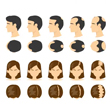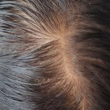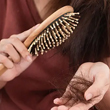Dihydrotestosterone (DHT) and Hair Loss - Everything You Need to Know

One of the most significant contributing factors of Androgenetic Alopecia (AGA) in men and women is Dihydrotestosterone (DHT). DHT is a sex hormone derived from testosterone and is responsible for the biological and sexual development of males. But when DHT is naturally synthesized in the body, why does it cause hair loss?
This article will answer some of these questions while also providing a few possible treatment options for DHT-related hair loss. Read on to know more.
What is DHT? 1,2

Dihydrotestosterone is an androgen responsible for the growth and development of male characteristics. It is synthesized in the body through the conversion of testosterone by the testes and prostate in men and ovaries in women. DHT is more potent than testosterone, and an increase in its production is responsible for the onset of puberty in boys. It also causes the development of male sex organs, pubic hair, and body hair.
DHT is beneficial as you grow older because it helps in maintaining muscle mass and fertility for longer. However, too much or too little amount of DHT can have adverse effects - women can develop hirsutism, amenorrhea, and acne. DHT can be one of the many causes of hair loss.
In men, it can lead to premature hair loss and AGA, among other complications. DHT is also known to trigger hair loss in both men and women, and studies have shown that it also leads to miniaturization of hair follicles gradually progressing to male pattern baldness.
Let's see how it is linked to hair loss.
How is DHT Linked to Hair Loss? 2,3

DHT is produced in the body continually after the breaking down of testosterone by an enzyme called 5α-reductase. In a way, DHT is a by-product that also helps in the development of mass and other functions of the body.
However, in men and women who have a genetic predisposition to AGA, it has been observed that DHT binds to specific androgen receptors and enters the hair nuclei to combine with the DNA. This activates the gene and production of proteins responsible for the gradual change of healthy hair follicles to miniaturized/shrunk follicles.
Eventually, it reduces the hair cycle, and the hair grows out thinner, more brittle in texture, and also falls out faster.
It reduces anagen and increases the telogen phase, and eventually causes gradual and progressive hair loss or AGA. The response of hair follicles to androgens is different, and hair follicles on the face, chest, and genitals actually show improved growth due to DHT. On the other hand, the hair follicles on the scalp inhibit hair growth with varying degrees of hair loss that differ from person to person. DHT is also known to make hair follicles take longer to grow once the hair falls out.
Treatment Options for Balding 4,5,6

There are many treatment options for hair loss. Some of them are as follows:
- Lifestyle changes: Change in certain lifestyle habits can help minimize the overall effect of DHT on your hair follicles. Habits like smoking can be detrimental to your overall health. Lifestyle changes like quitting smoking, exercising, yoga, or a balanced diet can reduce the overall stress and scalp inflammation if any.
- Herbal Products and Supplements: Green tea, turmeric are natural products that can reduce the impact of DHT on the body. Additionally, supplements like Biotin, Iron, Niacin, and vitamins can help improve hair loss and improve the overall health of your scalp and hair.
Conclusion
With proper care, improvement in lifestyle can delay baldness in patients with AGA. Suitable treatment options combined with a balanced diet will also reduce hair fall and improve hair growth with time. For understanding your scalp and diagnosing the real cause of hair fall, we advise you to visit your dermatologist for a comprehensive health check, diagnosis, and treatment guidance.
Myth Busters HairFall

Androgenetic Alopecia - Everything You Need To Know
Have you been experiencing excessive hair fall over a prolonged period of time? It could be an early sign of androgenetic alopecia. It is a hair loss disorder common in both genders and can lead to progressive thinning and even baldness in some patients if not caught and treated early.

How To Make Hair Grow Faster For Men
A head full of healthy hair is a matter of confidence. Hair has its own mechanism of growing and shedding, and it is when this mechanism is thrown off that growth is hindered. Especially in the case of males, hair growth faces a lot of hiccups that can easily be managed.

Female Pattern Baldness - Causes & Treatments
Have you suddenly noticed an increase in the number of hair strands on your pillow in the morning? Or is your ponytail getting thinner by day? Well, you might be suffering from female pattern baldness. While that does sound scary, identifying it early on is key to treating this condition effectively. So keep reading to know what this is, how you can identify it, and most importantly, what treatments you can avail of to get your beautiful lustrous hair back.

What Are The Reasons For Hairfall?
Almost everyone experiences some amount of hair thinning over the years. Shedding around 50 to 100 single strands of hair per day is considered normal. However, losing more than 150 strands a day, experiencing sudden thinning, or developing circular bald patches on your scalp are reasons for concern. Hair loss occurs when new hair doesn’t grow fast enough to replace the amount of hair you lose daily. Hair can fall due to various reasons, with hereditary hair loss and poor nutrition being the most common hair fall reasons.

Expert Approved Tips For Hair Growth
What can be more debilitating than seeing hundreds of hair strands shedding from your scalp every time you brush your hair? Also, excessive molting occurs during seasonal changes that can be very stressful for you. Although it’s okay to lose between 50-100 strands every day, according to the American Academy of Dermatology, the problem occurs when you start shedding more than normal. But that doesn’t mean you have to feel helpless as there are ways to grow your hair back. Even if you are coping with baldness or alopecia, certain hair growth tips from dermatologists can come to your rescue. Read on to discover how these tips can be your savior when abnormal hair fall problems are in sight.
Trending Videos
+ 8 Sources
'LMRC - GGI-CO-A2-DMA-300001252-300001252-WM-L21-704'
© 2021 Dr. Reddy’s Laboratories Ltd. All rights reserved.